![]() March-April 1999
March-April 1999
By Cindy Ross
Photographs by Todd Gladfelter and the Author
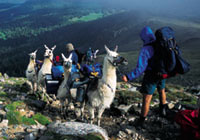 In Colorado's Mount Zirkel Wilderness, surefooted llamas carry the family's gear across the windy flanks of the Continental Divide. |
For the past five years, our family has spent two months or more each summer hiking the National Scenic Continental Divide Trail.
The 3,100-mile trail runs along the crests of the Rocky Mountains from Canada to Mexico, literally dividing the waters of North America. The range is the highest land in the country; to walk up there is to scrape heaven.
We covered about 500 miles each summer. Our "home" was carried on the backs of llamas, the camel-like animals native to the Andes Mountains of South America. These gentle creatures made it possible to bring up to 14 days of supplies, plus a tent, sleeping bags, backpacking stove, food, and clothing. Instead of a backpacker's menu of all freeze-dried food, we could have foods like fresh apples, bread, and cheese.
Our children, Sierra, 8, and Bryce, 6, hiked with us or rode the llamas. I led the two child-carrying llamas, while my husband, Todd Gladfelter, took the three pack carriers.
Much of the Continental Divide Trail is unfinished, just a designated route in a guidebook. Its remoteness meant we rarely saw other people, except for an occasional cowboy on horseback looking for a fence break or a stray cow.
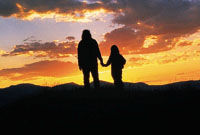 A sunset in the Beaverhead Mountains provides some lasting memories. |
During a typical eight-hour day, we would hike for an hour and a half and then break for an hour, at which time the kids played in creeks, climbed on boulders, and ate. Each night we camped in a new area, usually a site with water and a source of grass for the animals.
Every week or so, we came out of the mountains to replenish supplies at preplanned locations. We chose towns close to the trail that included a grocery store, laundry, post office, and other services.
Before our children were born, Todd and I covered the entire 2,100-mile Appalachian Trail in the East and the 2,600-mile Pacific Crest Trail in the West. By writing about our travels, I was able to turn this love into a job, a livelihood.
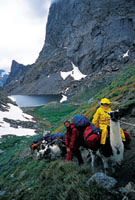 The family climbs over Jackass Pass in the Wind River Range in Wyoming. |
After Sierra and Bryce were born, we wanted to include them in our wilderness experiences. Fortunately, we discovered that llamas make great pack animals and child carriers.
In 1993, sponsored by the Buckhorn Llama Co. of Masonville, Colo., we took our first llama hike on the 500-mile Colorado Trail through the Rockies.
We had concerns about the kids hurting themselves; fears of mountain lion attacks, lightning strikes, and snow traverses. We contacted the Colorado Department of Wildlife to learn where we could expect to find lions, their habits, and what to do in the event of an encounter.
Our goal was to complete the entire 500-mile Colorado Trail in one summer. Sierra rode a llama, while Todd or I carried Bryce, who was only a year old, in a special child carrier. Two other llamas carried our gear, which included 100 cloth diapers for Bryce.
Those diapers turned out to be our greatest challenge. Their contents had to be disposed of by digging holes and burying them. Then, at a spot away from any water sources, we had to rinse out the diapers and store them in a plastic bag until a laundromat was available.
Despite the diapers, we realized after only one week what a gift it was to have our children with us.
We weren't sure, however, if they would enjoy life on the trail. A long-distance trek is not a vacation; it's a way of life and not always easy.
But trail life felt natural to Sierra and Bryce. They were with their parents, who were taking care of their needs, and where they were didn't seem to matter. Cold, rain, and wind bothered them less than it did us. They rarely bickered and were captivated by all the new things in their lives.
And they never got sick. For minor emergencies and mishaps, we carried some pharmaceuticals and an extensive first-aid kit. For anything truly serious, one of us was prepared to descend from the trail to a road to arrange for a rescue helicopter. But no one had so much as a cold - thanks to clean air, a healthy life style, and a lack of germs transmitted from large groups of people.
Before we left with the children on our Colorado Trail trip, people would comment that it was "too bad you can't leave the kids with someone."
But we soon discovered that being with the children was at least half our joy. To see a waterfall or a sunset through their eyes was to see it as never before. Hiking the Colorado Trail fused us as a family and instilled a love of the outdoors in our children.
The children are equally at home on a wilderness trail or in our backyard in Pennsylvania, for both locations are their homes.
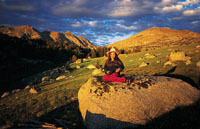 Sierra takes in the grand vistas of Montana's Bitterroot Mountains. |
Learning low-impact, backcountry ethics - like washing up with water from a pot instead of in a creek - are practices we taught them as toddlers. They know how to traverse snow slopes, rock-hop on boulders across a creek, and choose the best cross-country route when there is no trail. They know how to walk their own switchbacks to go light on the land (and themselves).
They have been immersed in the wild world: They've watched clouds expand, beavers build dams, stars twinkle. They've seen rainbows materialize before their eyes, heard elk bugle, and listened to glaciers scour down the mountains.
When Sierra sighed and gazed into a golden sunset and said, "Don't you wish you could be there, Mom - right there, in the sky, where it's glowing?" I knew that nature's magnificence had possessed them and showed them their place in the natural world.
After we completed the Colorado Trail, Todd and I agreed our next challenge would be the 3,100-mile National Scenic Continental Divide Trail. We would need at least five summers to cover the Canada-to-Mexico route. In preparation, we bought our own llamas and brought them back to Pennsylvania.
And during those five summers we've had some memorable experiences, like being chased by buffalo and moose in Yellowstone National Park. (They were simply curious about our llamas.)
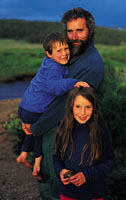 Todd, Bryce, and Sierra reflect sunset's golden glow. |
Because there are few bridges in the wilder backcountry, we've forded river rapids carrying our kids in a child carrier on our backs, steadying our step with hiking sticks. We've been in wind so fierce the llama saddles were blown loose and the kids felt as if they couldn't breathe.
When potential dangers are involved, Todd and I are quite skilled at evaluating situations for the amount of risk. If we feel uncomfortable, we do not proceed.
The children are troopers and almost always smile. When things get rough, they never complain. They might whine over the presence of chopped red peppers in yet another evening meal, but the strong winds and storms, the serious stuff, they seem to handle. I think they're learning, even at their young ages, that there are some things in life you must just learn to deal with and get through the best way that you can.
They're also learning that there is a balance out there. There is order and fairness. If you want wildflowers and waterfalls, you have to experience rain. To appreciate gifts of kindness from people, you have to experience deprivation.
Our experience in tiny Pie Town, N.M., best illustrates this. We had looked forward to enjoying some of the local homemade pie, but upon arriving we discovered that the restaurant that served the pie had closed down the day before. To add to our disappointment, the closed building also housed the town's only grocery store.
We had nothing to eat but old trail mix. It began to rain and we were feeling pretty sorry for ourselves. Then the storm cleared, a rainbow appeared, and so did a man in a pick-up truck.
"Come on down to our home for dinner," he said. "My wife just put in a pork roast."
His wife greeted us wearing a T-shirt that said: "No rain. No rainbows." Sierra and Bryce were amazed. They got it. "You can't have one without the other," they said.
The lack of built trail in New Mexico means hikers have to walk along roads, with as much as 50 miles between water sources. We decided the only feasible way to cover the final 650 miles to the Mexico border was on bicycles.
We boarded our llamas and traded them for tandem mountain bikes which we had trucked with us from the East. Special devices were attached to the rear (stoker) position so the kids could reach the pedals. Bryce rode with Todd, and Sierra, with me. They didn't have to push, but they did have to pedal. Each bike pulled about 80 to 100 pounds behind in a trailer.
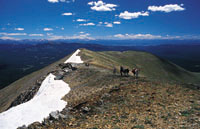 The Continental Divide Trail follows the ridge of Elm Mountain in Montana. In Wyoming's Teton Wilderness. |
Most of the route was on blacktop, some dirt, some single track. The desert heat and lack of water were big challenges, but we were able to stop for cold drinks and ice cream at roadside stores. It was a happy day when we reached the border, completing our five-year journey.
In the past five summers, we've been together as a family for 24 hours a day. We are very close and enjoy each other's company.
We know that, if we avoid the hardships, we won't experience the gift. The gift for us is the closeness of family and the connection to the earth. There is a bond that naturally and inevitably comes from sharing the same sun, the same sky, the same river fords, the same highs and lows.
At home, living in our separate, atmosphere-controlled cubicles, we can stay protected from the wind and the rain and the sun and easily live a life where we share very little with our fellow man. So we naturally begin to feel isolated from one another and the natural world. But in a situation like trail life, you've got to bond.
Todd and I seem to need a certain amount of adventure in our lives, and long-distance hiking and biking satisfy that need. I don't expect my children to fall in love with hiking, but I want them to fall in love with life - to believe their dreams can come true and work hard to make them happen.
The Continental Divide Trail has shown them how that can be done.
Cindy Ross is the author of five books on hiking and the outdoors. She serves as the Brownie leader for daughter Sierra's troop, with her husband, Todd, as her assistant.
Llamas Are Mellow, Trail-Wise, Low-Impact Hikers
Llamas are true "low-impact hikers." Their eating philosophy is "All the world's a salad bar," and they will nibble on what grows alongside the trail. Their droppings are small pellets similar to an elk's and can easily be kicked off the trail by the last person in a hiking party. 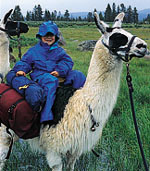 Cousins to the camel, they do not require a lot of water - usually a gallon a day - and their two-toed, padded hoofs make them surefooted on the most rugged terrain. At 6 feet tall, 350 pounds, llamas are big. Their willingness to follow obediently while carrying 60 to 120 pounds and their gentle nature made them our immediate friends. They seem to sense a child's vulnerability, for they are remarkably tolerant of the "abuse" doled out by small children. And children are constantly entertained by their presence and curious behavior, which relieves boredom on a hike of any length. Llamas spit when annoyed, but rarely at humans. They might spit a green chew of grass at another llama over food, but usually they try to move away from any annoyance. Most llamas can be trained as packers. Led by a rope, a llama will follow at your pace, even one set by a small child. Mellow, trail-wise llamas make the best kid-carriers. Children can begin to ride at about 2 or 3 years old. A medium-sized, conditioned llama can carry a child weighing up to 60 pounds. You can sample llama-packing by taking a trip with a commercial packer. (Most do not have insurance to cover riders, however.) A very small child can ride in a carrier on a parent's back, or you can set the pace to the youngest hiker and use the llamas to carry gear and equipment to take your family into remote wild places. For a listing of commercial llama packers, contact
- C.R. |
Family Wilderness Camping: Start by Learning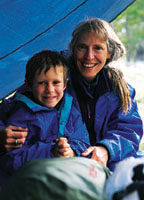
A family considering a llama pack trip, or any type of wilderness trek, should have camping and hiking experience. Before taking children along, parents need a solid foundation of basic backcountry skills and knowledge. Here are some key tips:
- C.R. |
| The Boy Scouts of America | http://www.scouting.org |